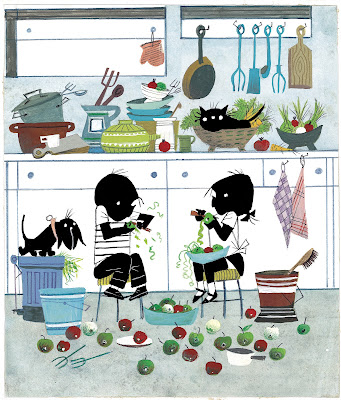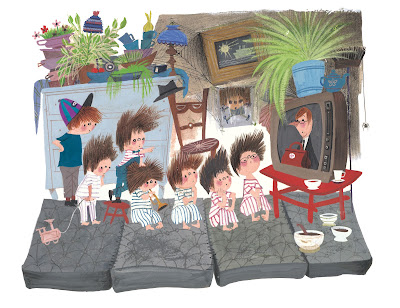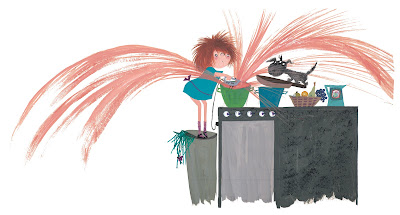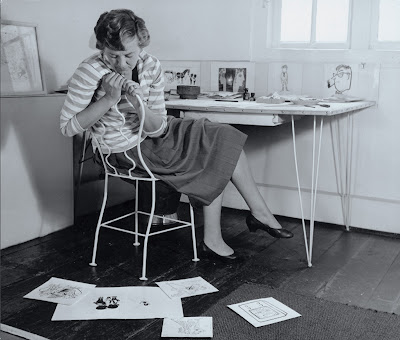INSPIRATIONS FROM THE BOOKSHELF Fiep Westendorp
The characters Jip and Janneke are as famous in Holland as Mickey and Minnie Mouse. Everyone knows them.
I was four when I was introduced to their books. I didn’t know about illustrators or writers, I just enjoyed the stories and the black and white pictures in the paperback from which my mother read to me. I still have that first book, tattered and taped, its pages yellow with age.
The name of the book’s illustrator was Fiep Westendorp and the writer Annie M.G. Schmidt. They both died a while ago, but they remain a legendary duo in Holland. Interesting to note, though, that Fiep’s name is not mentioned on the cover of my 1970 copy. Things have changed a bit in 50 years!
 |
| Jip snijdt zich (Jip cuts himself), Jip en Janneke, Annie M.G. Schmidt & Fiep Westendorp, from Bobo, 1980 |
Every Saturday morning, my mother would take my brother and me swimming and then afterwards (dressed in my 70’s pink tricot jumpsuit) to the library to stock up on new books for the week. I quickly recognised Fiep’s illustrations. You just knew, when you saw a book in her distinctive style, that book was going to be fun. And you wanted it. Badly.
 |
| De televisie, Pluk van de Petteflet (The television, Tow-truck Pluck), Annie M.G. Schmidt & Fiep Westendorp, from: Margriet, 1969 |
I especially loved Floddertje and Smeerkees (Scrumple and her dog Splodge), another pair of Fiep’s iconic characters. Floddertje was me, a child always ending up with stains on her clothes. I even had a little dog, just like Floddertje.
 |
| Floddertje (Scrumple) 1 - Opgesloten, Annie M.G. Schmidt & Fiep Westendorp, Nutricia, 1968 |
One night my mother found me crying in bed, because I wanted a Floddertje book so badly. Not just from the library, I wanted to own it. Normally we were only given presents on Birthdays or at Sinterklaas (when Dutch children get their presents instead of Christmas), but my Mother could see my distress was real and the next day we went to the book shop. I suspect she always had a soft spot for Fiep’s work too. I think her favourite was Tow-Truck Pluck though. Same for my brother.
 |
| Pluk op de pont van de heen-en weerwolf, (Tow-Truck Pluck on the ferry of the Tell-Me-Where Wolf) Pluk van de Petteflet, Annie M.G. Schmidt & Fiep Westendorp, from Margriet, 1969 |
My mother always tried to get me outside to play with other children, but all I wanted to do was read and draw. I remember if I was ever stuck on how to draw something, I’d look through my books to see how Fiep had drawn it.
 |
| Floddertje (Scrumple) 5 – Moeder is ziek, Annie M.G. Schmidt & Fiep Westendorp, Nutricia, 1969 (pencil, pen, ink and gouache) |
 |
| Floddertje (Scrumple) 5 – Moeder is ziek, Annie M.G. Schmidt & Fiep Westendorp, Nutricia, 1969 |
Fiep (Sophia Maria Westendorp) was born in Holland on the 17th of December 1916. From a young age she enjoyed drawing and it was soon clear that she had talent. In 1930’s Holland, girls studying art was pretty unusual. But her parents were supportive and after she left high school they allowed her to attend the Royal College of Art and Science in Southern Holland. She was the only girl in her class.
After College she progressed to the Academy of Fine Arts in Rotterdam, where she explored all kinds of art forms, from life drawing to botanical drawing to painting, to design and etching, which she particularly enjoyed. She was in her element and absorbed everything she could.
Fiep was twenty three when WWII intervened. Having invaded Holland, the Nazis made an example of Rotterdam. Within days of blanket bombing, they had destroyed most of the city, including the Academy. It was a message to the country, showing what would happen to rest of Holland if they didn’t surrender. Totally out-numbered, the Dutch had no choice. But there was still resistance, and Fiep joined it later in the war. The skills she had learned at college and the academy were put to good use, faking ID documents and providing maps and sketches of certain locations to help the allied war effort.
For a while Fiep moved to the Hague during the war, where she shared a house with her friend, the poet Clara Eggink. Clara’s home turned out to be a popular watering hole for many of the city’s writers, poets and journalists, useful contacts when after the war Fiep moved to Amsterdam to make a career for herself. Working for advertising agencies, newspapers, magazine and literary publishers, her illustrations made people smile. After the horrors of war, everyone craved humour and her illustrations were in demand.
 |
| Moeten mannen meehelpen in de huishouding? (Do men need to help with household tasks?), Mr. Hanni Singer-Dekker, Het Parool, 30-1-1958 |
It was while regularly illustrating a woman’s (early feminist) column in a national newspaper, Het Parool, in the late 1940’s, that Fiep met Annie M.G. Schmidt. From 1952 onwards, they worked together on the Saturday children’s section, with Fiep illustrating Annie’s weekly adventures of Jip and Janneke in black and white. After Jip and Janneke came Pim and Pom by Mies Bouhuys, by which time Fiep was well established as a children’s illustrator.
Fiep has illustrated many books and her unique style makes her illustrations instantly recognisable. The way she draws eyes in particular: little circles or dots, placed wide apart with upturned noses high, sometimes even above the eyes. Anatomically impossible, but it works. She conveys expressions and emotions through the simplest of lines.
 |
| Floddertje (Scrumple) 6 – Tante is jarig, Annie M.G. Schmidt & Fiep Westendorp, Nutricia, 1969 |
With her intricate knowledge of anatomy and her extensive experience of life drawing - at college, but also sketching whenever and wherever she could - she understood how the body and facial expressions work. And from that knowledge she could abstract them, creating empathetic characters. She also created cosy environments for her characters with quirky furniture and patterned fabrics.
 |
| Portret van een oude vrouw met Brabantse kap, November 1938 (houtskool) - portrait of an old woman with a cap from Brabant, November 1938 (charcoal) |
 |
| Het schaap Veronica, (Veronica the Sheep), Annie M.G. Schmidt & Fiep Westendorp, Querido, 1972 |
Later, when the stories were published as books and illustrations no longer restricted to black and white, her bright, cheerful and often unexpected colours added an extra level of originality, not realistic, but always believable.
Learning more about her life and work, and doing illustration work myself, I was surprised by some of the materials she used. Particularly gouache, which was unexpected for me. When I use it, it always seems to be a bit flat and dull. But when Fiep uses gouache, her images sing. Looking closer at her work, you will also find funny little pieces of collage and mixed media.
 |
| Een nieuwe kalender (A new calendar), Jip en Janneke, Annie M.G. Schmidt & Fiep Westendorp, from Bobo, 1978 |
She enjoyed working with pen and ink and her use of inks together with pencil I find extraordinary too. I’m not aware of other illustrators using them that way. But it works.
 |
| Pauliens stoeltje (Pauline’s Chair), Marjolein Heijermans & Fiep Westendorp, Het Spectrum, 1974 |
But for all her technique and original use of colour, it’s her humour that stands out. It’s what hooked me as a child and makes her loved by a whole nation.
 |
| Portrait of Fiep in her studio in 1957, photo credit: W.P. van de Hoef |
With special thanks to Anneke Eijkelboom from Fiep Amsterdam BV who kindly helped select and provide the illustrations for this article.
Copyright all illustrations: ©Fiep Amsterdam BV; Fiep Westendorp Illustrations
*Header image, Jip fietst (Jip is cycling), Jip en Janneke,
Annie M.G. Schmidt & Fiep Westendorp, from Bobo, 1979
Reference books:
Getekend: Fiep Westendorp, by Gioia Smid
Voor de vrouw maar voor haar niet alleen. Fiep Westendorp in the krant, by Gioia Smid
*











I recently discovered Fiep’s work and love it! Thank you for this informative post. I’m trying to learn as much as I can about her.
ReplyDelete